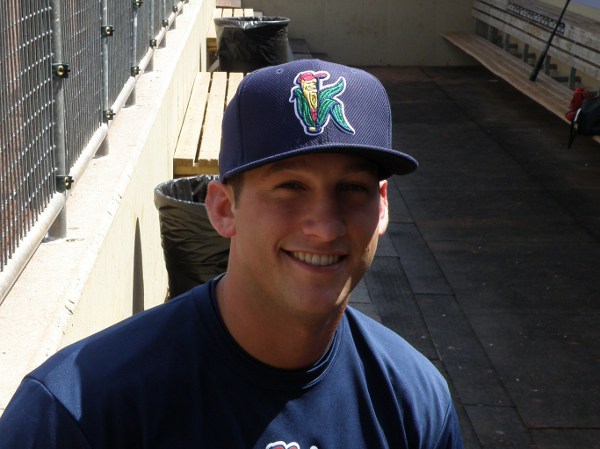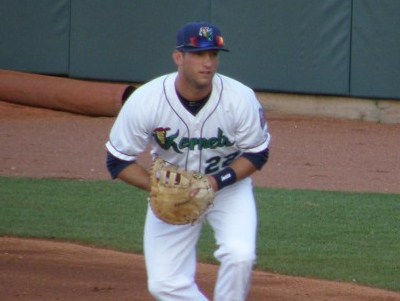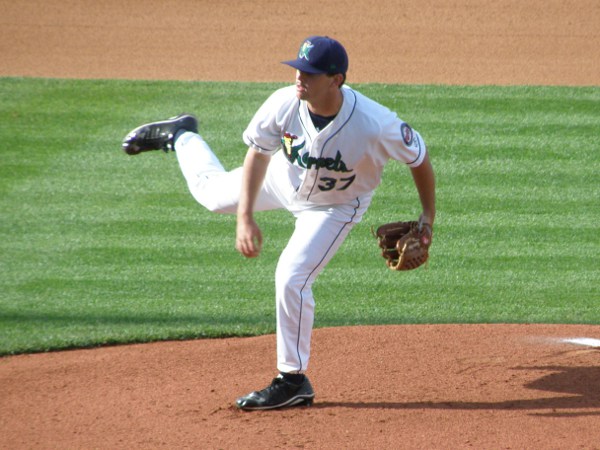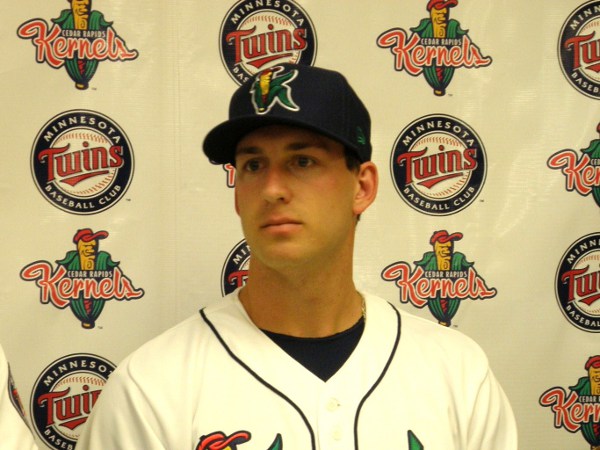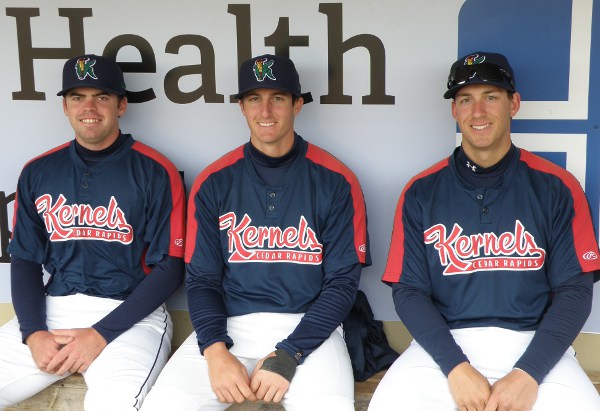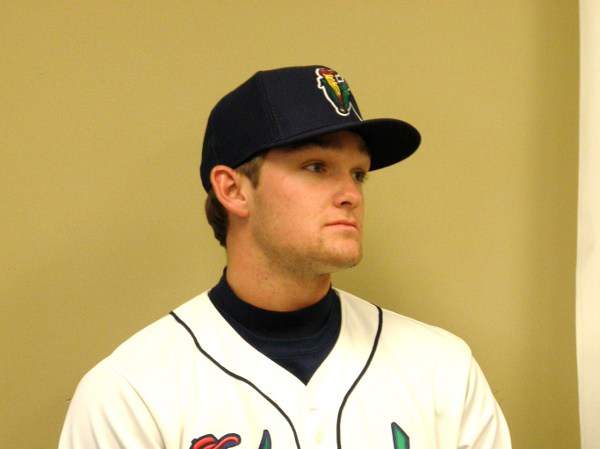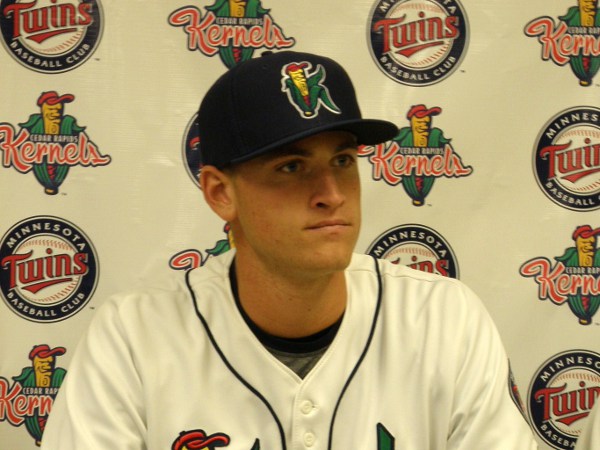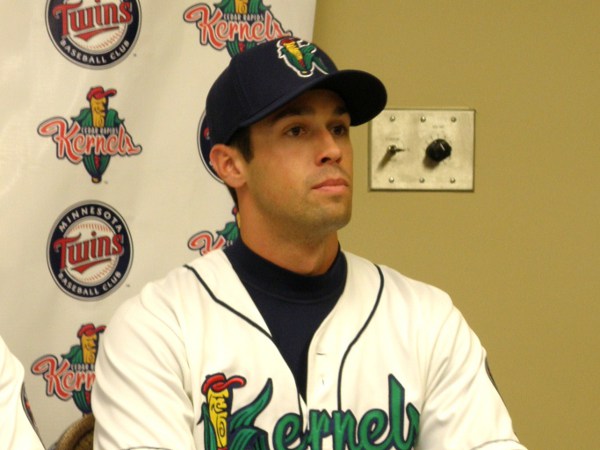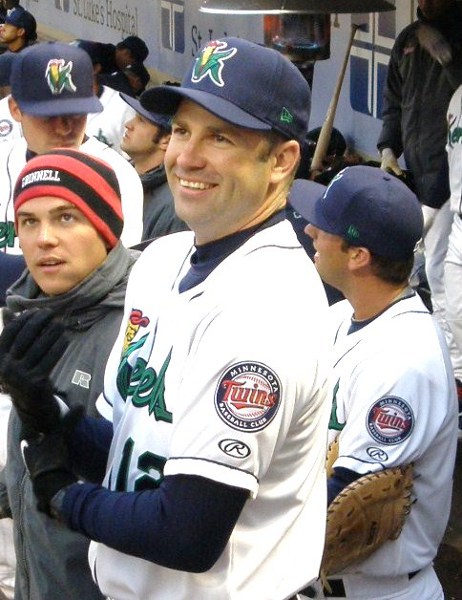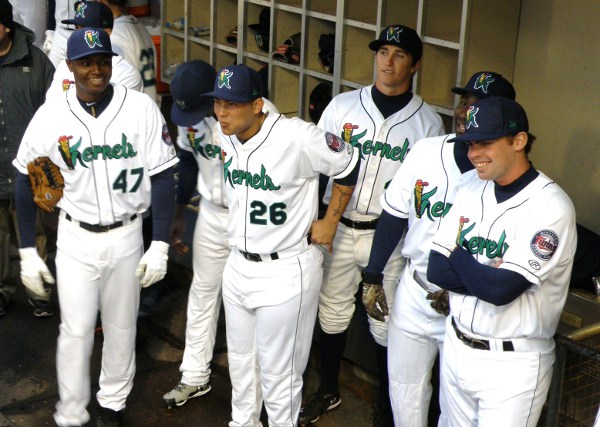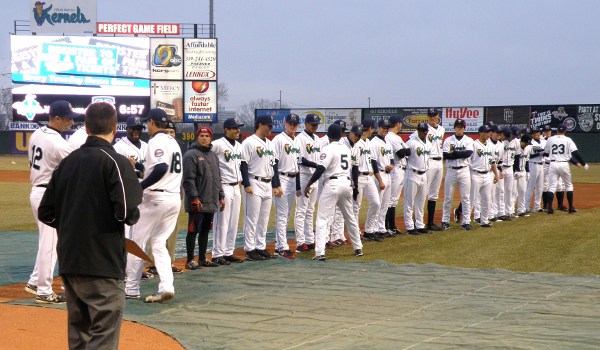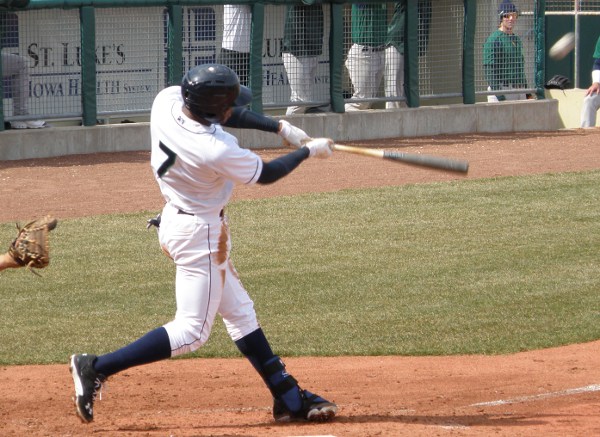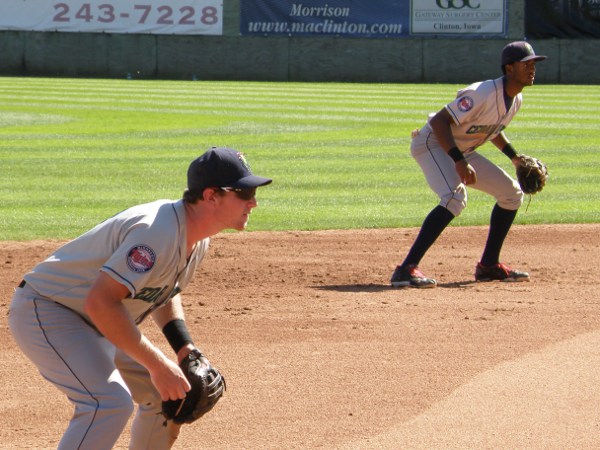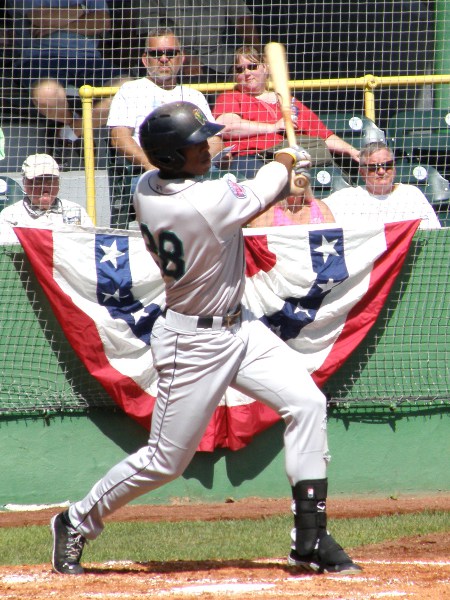Heading in to the 2014 season, everyone pretty much had expectations in check with regard to the Cedar Rapids Kernels. The team’s fortunes would likely turn on the performance of a staff of young, highly heralded pitching prospects. The offense, meanwhile, could very well struggle to score enough runs to keep the Minnesota Twins’ Midwest League affiliate competitive.
As they near the end of the first month of the season, however, the Kernels are two games above .500 with a 13-11 record and the hitting is at least as responsible for that success as the pitching staff is.
Infielder Tanner Vavra and outfielder Zack Larson are just two of the Cedar Rapids players making major contributions with their bats. Before Tuesday night’s game with Kane County, Vavra and Larson talked about their season thus far.

Vavra, the son of Twins coach Joe Vavra, spent a few days recently at the very top of the Midwest League’s leader board in batting average and still leads his team with a .344 average. He’s also reaching base at a .391 rate and carries an .829 OPS through Tuesday’s games.
While most fans may not have expected that kind of production out of Vavra, neither he nor his manager seem terribly surprised, either.
“He’s a guy that really obviously has been around the game his whole life, with his dad being a professional baseball guy,” said Jake Mauer of his second baseman. “He’s got a lot of baseball instincts. He knows himself as a player. He knows what he needs to do and he plays to his strengths. He’s a guy that puts together good at-bats. He makes the routine plays. He’s definitely earned his playing time.”
“I’m just trying to put good swings on (the ball) and help the team win,” said Vavra of his hot start to the season. “I’m just trying to stay with the same approach and kind of just get my pitch and get on base for guys like Larson here to drive me in.”
Meanwhile, Larson’s also got a pretty impressive early-season slash line, as well with a .307 batting average, a .351 on-base percentage and an .806 OPS. That’s not a bad start for a 20 year-old in his first year with a full-season affiliate.
“He’s really come on for a younger guy and made some adjustments.” his manager said of Larson. “He was having a little hard time with offspeed pitches, but that’s not the case any more. He’s doing a nice job out in right field. He’s going to hit in the middle of our order and he’s getting even better in the outfield and that’s pretty encouraging to see.”
Larson’s just as humble as Vavra when asked about his contributions, too.
“Like Tanner, I’m just trying to put good swings on it,” said Larson. “That’s my main focus, put a good swing on the ball and hopefully good things happen.”
Both hitters have been particularly productive at the plate with team mates on the bases. In fact, both Vavra and Larson are hitting at a .400 clip with runners on base.
Neither man claims they do anything special in those situations, though.
“I don’t like to get out, so I try to take the same approach with runners on or runners not.” said Vavra, laughing.
Added Larson, “Just barrel it up and put a good swing on it. I try to do that every at-bat; stay focused.”
The two team mates may be making similar contributions to their team’s cause this season, but they come at their tasks from very different backgrounds.
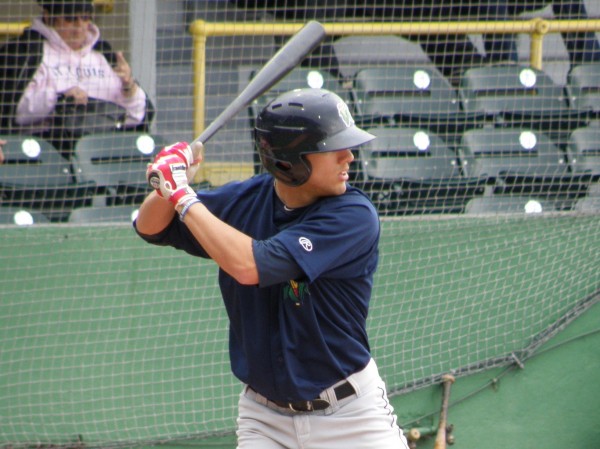
Larson was drafted by the Twins in the 20th round of the 2012 First Year Player Draft out of his Bradenton, Florida high school.
A 24 year-old from Wisconsin, Vavra played college ball at Valparaiso University before being drafted by the Twins in the 30th round of last June’s draft.
A year ago, top Twins prospects Jorge Polanco and Adam Brett Walker were manning the positions that Vavra and Larson are holding down this season. Both guys just smile when asked about trying to live up to the offensive legacy of last year’s Kernels.
“I think we all knew it was going to be tough to follow in the footsteps of the team from last year and we were never trying to do that,” said Vavra. “We’re never trying to live up to what they did last year, because, let’s face it, that’s pretty special what everybody got to see with the number 1 prospect in all of baseball playing (in Cedar Rapids).”
“With that being said, our goal is still the same,” Vavra added, “to get to the playoffs and put good seasons together individually and have a great team season. Hopefully take it one step farther and get that ring.”
And maybe do enough to get a promotion to the next level in the organization?
“Everyone wants that,” acknowledged Larson, “but you can’t control that. You can only control what you do. Can’t worry about that.”
Larson shares the Midwest League lead with 10 doubles already this season, just one shy of his total two-baggers during his 55 games a year ago at both rookie league levels combined. Then again, he had five home runs last season and has just one as a Kernel.
But don’t expect Larson to feel disappointed with his results so far.
“I’m not disappointed at all,” Larson explained. “I’m not worried about hitting home runs. I’m just worried about helping the team win and putting good swings on the ball and if I hit a home run, it’s cool. Whatever I can do to help the team.”
“He’s young.” chimed in Vavra, about his team mate. “He’s still got a lot of manpower to come his way. This is his first full season. You never know, he might catch hot in July once the weather warms up and you’re going to see big things out of him.”
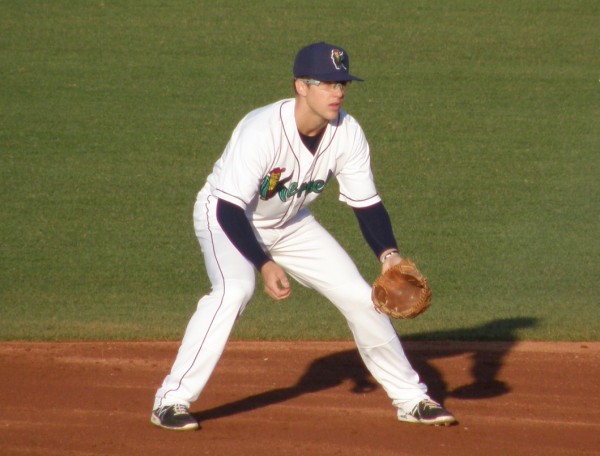
Vavra’s complete story can’t be told without mentioning that he’s blind in his right eye, the result of a fishing accident at age three and a subsequent injury suffered playing football several years later.
His ability to play baseball at a professional level with that limitation inevitably comes up during interviews. That could give a player a bit of a chip on his shoulder, but Vavra said questions about his eyesight don’t bother him much anymore.
“It’s kind of came and gone. That used to be the biggest concern.” said Vavra. “People doubted me.”
“It irritated me for a while and it’s still a little chip,” Vavra continued, “but I’m just trying trying to get rid of the whole, ‘You’re here because of your dad,’ type deal.”
“I haven’t gotten anything like that from the players, they’ve all been great. I haven’t heard that once. It’s from bloggers and those people that somehow send a letter to your house and tell you that you don’t belong. That’s my chip right now. The eye thing is always going to be there, but that’s my new chip.”
While it’s understandable that Vavra would be sensitive to suggestions that he hasn’t earned his place in pro ball, having a father in the game has its benefits.
“This offseason, I got to work with him for 5-6 months. That’s incredible. Going from usually working with him for three or four weeks over Christmas break to five months. It was definitely helpful.”
While Vavra was spending his offseason working out indoors in Wisconsin with his dad, Larson was wintering in a much warmer climate.
“Down in Bradenton, I give lessons at an indoor batting facility and my hitting coach is also there,” said Larson, of his offseason. “I hit with him and work out, try to get in the best shape I can before the season starts. Every day, hitting cage, doing something with baseball.”
Larson arguably seemed to have an edge on non-baseball related activities.
“I go to the beach. Beach is a big thing in Florida,” said Larson. “Just hang out with my friends. I don’t see them that often. They’re in college when I’m back at home.”
Vavra, on the other hand, “did a lot of hunting and fishing. Different fishing though, dropping a line through the ice.”
The look on Larson’s face, hearing that, gave the impression he wasn’t inclined to trade offseasons with his team mate.
– JC

